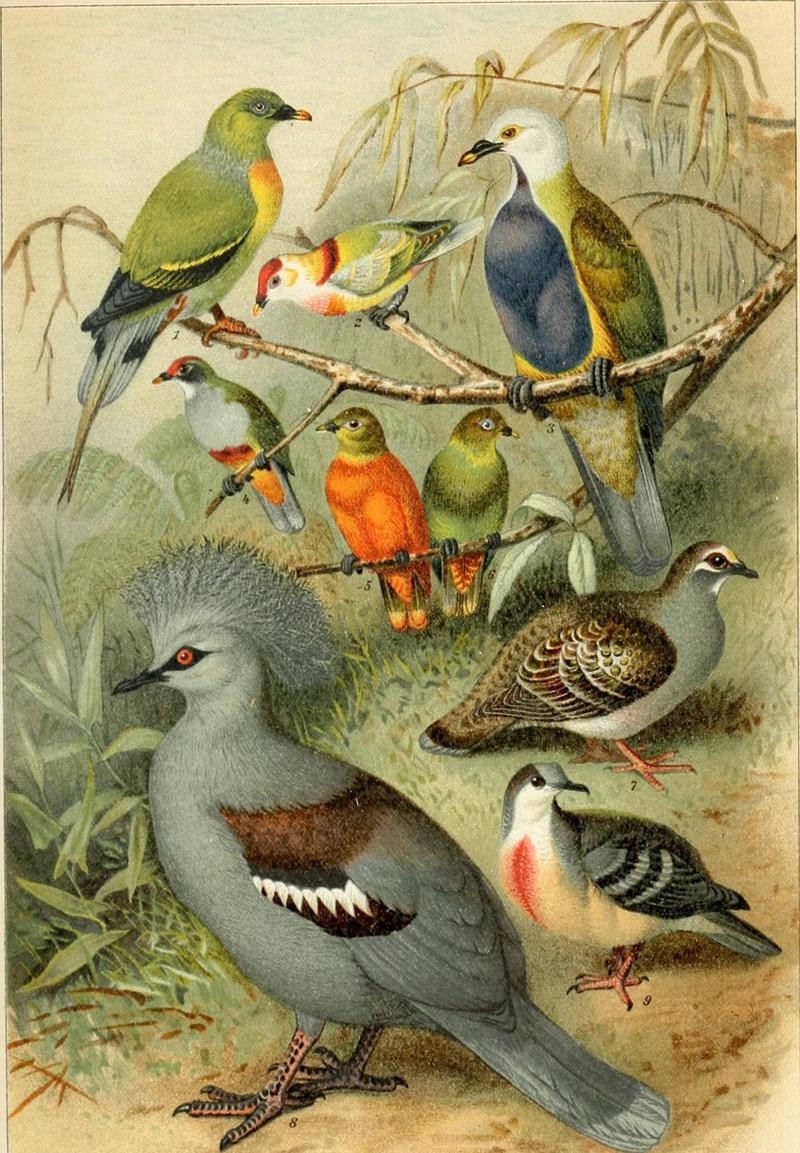|
| Query: Ground dove | Result: 85th of 126 | |
Columbidae. 1. Sphenocercus apicaudus = Treron apicauda (pin-tailed green pigeon). 2. Ptilinopus Peyrousei = Ptilinopus perousii (many-colored fruit dove). 3. Megaloprepia magnifica = Ptilinopus magnificus (wompoo pigeon). 4. Cyanotreron pulchellus = Ptilinopus pulchellus (beautiful fruit dove). 5,6. Chrysoena Victor = Ptilinopus victor. 7. Phaps chalcoptera (common bronzewing). 8. Megapelia coronata = Goura cristata (western crowned pigeon). 9. Geotrygon cruenta = Gallicolumba luzonica (Luzon bleeding-heart)
| Subject: | Columbidae. 1. Sphenocercus apicaudus = Treron apicauda (pin-tailed green pigeon). 2. Ptilinopus Peyrousei = Ptilinopus perousii (many-colored fruit dove). 3. Megaloprepia magnifica = Ptilinopus magnificus (wompoo pigeon). 4. Cyanotreron pulchellus = Ptilinopus pulchellus (beautiful fruit dove). 5,6. Chrysoena Victor = Ptilinopus victor. 7. Phaps chalcoptera (common bronzewing). 8. Megapelia coronata = Goura cristata (western crowned pigeon). 9. Geotrygon cruenta = Gallicolumba luzonica (Luzon bleeding-heart)
| | Poster: | Wiki Photos (---@---.---)
| |

| Resolution: 1568x2260
File Size: 551410 Bytes
Upload Date: 2023:03:24 10:02:44
|
1. Sphenocercus apicaudus. 2. Ptilinopus Peyrousei. 3. Megaloprepia magnifica. 4. Cyanotreron pulchellus. 5. Chrysoena Victor, Männchen. 6. desgl. Weibchen. 7. Bronzeflügeltaube (Phaps chalcoptera). 8. Kronentaube (Megapelia coronata). 9. Dolchstichtaube (Geotrygon cruenta).
Title: Brockhaus' Konversations-Lexikon
Year: 1892 (1890s)
Book page: https://archive.org/stream/brockhauskonvers15leip/brockhauskonvers15leip#page/n739/mode/1up
Source: https://commons.wikimedia.org/wiki/File%3ABrockhaus%2527_Konversations-Lexikon_%281892%29_%2814781374951%29.jpg
1. Sphenocercus apicaudus = Treron apicauda
The pin-tailed green pigeon (Treron apicauda) is a species of bird in the family Columbidae native to Southeast Asia. The pin-tailed green pigeon is found in Bangladesh, Bhutan, Cambodia, China, India, Laos, Myanmar, Nepal, Thailand, and Vietnam.
2. Ptilinopus Peyrousei = Ptilinopus perousii
The many-colored fruit dove (Ptilinopus perousii), also known as manuma in the Samoan language, is a species of bird in the family Columbidae. It occurs on islands in the south-west Pacific Ocean where it is found in Fiji, the Samoan Islands, and Tonga.
3. Megaloprepia magnifica = Ptilinopus magnificus
The wompoo fruit dove (Ptilinopus magnificus), also known as wompoo pigeon, is one of the larger fruit doves native to New Guinea and eastern Australia. The wompoo fruit dove can be seen in large flocks where food is abundant.
4. Cyanotreron pulchellus = Ptilinopus pulchellus
The beautiful fruit dove (Ptilinopus pulchellus), also known as the rose-fronted pigeon or crimson-capped fruit dove, is a small and mainly green fruit dove. It has a red crown, whitish throat, a greenish-yellow bill and purplish-red feet. The beautiful fruit dove is distributed in rainforests of New Guinea and the islands of Batanta, Waigeo, Salawati and Misool in West Papua, Indonesia.
5. Chrysoena Victor, Männchen = Ptilinopus victor male
6. desgl. Weibchen = Ptilinopus victor female
The orange fruit dove (Ptilinopus victor) is a species of bird in the pigeon family Columbidae. One of the most colorful doves, the male has a golden olive head and elongated bright orange "hair-like" body feathers. The orange dove is endemic to Fiji.
7. Bronzeflügeltaube (Phaps chalcoptera) = common bronzewing (Phaps chalcoptera)
The common bronzewing (Phaps chalcoptera) is a species of medium-sized, heavily built pigeon. Native to Australia and one of the country's most common pigeons, the common bronzewing is able to live in almost any habitat, with the possible exception of very barren areas and dense rainforests.
8. Kronentaube (Megapelia coronata) = western crowned pigeon (Goura cristata)
The western crowned pigeon (Goura cristata), also known as the common crowned pigeon or blue crowned pigeon, is a large, blue-grey pigeon with blue lacy crests over the head and dark blue mask feathers around its eyes. Goura cristata is one of the largest members of the pigeon family Columbidae. It is endemic to the lowland rainforests of northwestern New Guinea.
9. Dolchstichtaube (Geotrygon cruenta) = Luzon bleeding-heart (Gallicolumba luzonica)
The Luzon bleeding-heart or punay (Gallicolumba luzonica) is one of a number of species of ground dove in the genus Gallicolumba that are called "bleeding-hearts". The native name in Tagalog is punay. It is also known as paloma de punalada 'stabbed pigeon'. The Luzon Bleeding-heart is the species in which the "blood" feature is most pronounced, with the reddish hue extending down the belly, furthering the illusion of blood having run down the bird's breast. |
^o^
Animal Pictures Archive for smart phones
^o^
|
|